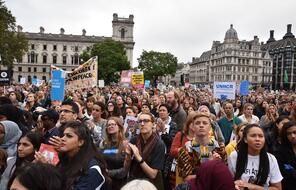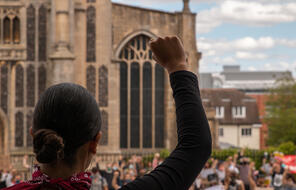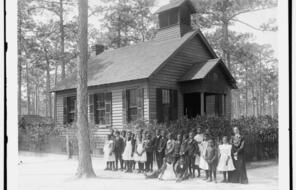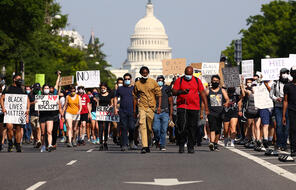The Impact of the Earthquake in Syria and Turkey
At a Glance
Language
English — USSubject
- Social Studies
- Human & Civil Rights
- Democracy & Civic Engagement
The Impact of the Earthquake in Syria and Turkey
Read the following information about the earthquake and descriptions of its impacts on people.
Background Information:
Before dawn on February 6, 2023, a 7.8 magnitude earthquake hit Turkey and Syria, with devastating impacts on the people living in the affected regions. The initial earthquake was followed by a series of aftershocks, including another 7.5 magnitude quake.
The World Health Organization estimates that 23 million people could ultimately be impacted by the earthquake, with as many as 20,000 losing their lives. 1 Millions of people living in the region had previously been displaced by the 11-year civil war in Syria and were already vulnerable before the earthquake struck. 2
Within two days of the earthquake, almost 100,000 people in Turkey mobilized to help take care of people and search for survivors, 3 including volunteers from across the country and professional search and rescue teams from around the world. Distributing aid in Syria is more difficult due to the civil war, but local groups, such as the civil defense group known as the White Helmets, have organized search and rescue operations. 4
Excerpt from “Syrian teacher recounts how children in Idlib refugee camp reacted to earthquake,” in The Washington Post:
Ten hours after the earthquake woke her 40 students in an Idlib refugee camp [in Syria], Yosra Alahmad, who lives in Berlin and teaches the children virtually, finally heard from Mudar, the 23-year-old who helps facilitate the classes. They had all survived, he told her. The children lived in tents, so they weren’t at risk from a building collapsing on them. But nine were injured.
“If you saw me yesterday, you would see my eyes were swollen from crying all day,” Alahmad told The Washington Post in Arabic. “It was one of the hardest days of my life.”
Many of Alahmad’s students, ages 5 to 17, are orphans, their parents killed in the [Syrian civil] war. She sees them as her own children, and tries to parent and support them from Germany. They rely on each other to get food and survive in the camp, and didn’t realize that the shaking they felt and heard was not an explosion but an earthquake.
“They thought they might die,” Alahmad said. They weren’t sure how long the ambulance sirens lasted, but the ringing seemed endless, she said.
On the video call, several of her students passed around Mudar’s phone so Alahmad could see their eyes lit up by the screen — their faces were otherwise dim from the power outage. It was raining and cold, and none had jackets with them, they told her. It took hours to receive any food after the quake, and the injured children were waiting to be seen at the makeshift camp clinic, which had few doctors.
Alahmad had known many of them since last spring, when she started teaching Arabic and English virtually in the An-Nur refugee camp, and hoped to send them aid.
But as a refugee herself, Alahmad has little money. She plans to collect donations from her other Syrian friends in Germany and send it to someone in Turkey as soon as she can. She hopes the money will then get taken to another nearby refugee camp in northwestern Syria, she isn’t sure by whom, and eventually to the 40 kids.
“I want to send help, but it’s hard,” she said. “It’s just tragedy after tragedy.” 5
Excerpt from “More than 4,300 dead in Turkey and Syria after powerful quake,” from CNN:
“We cannot use the buildings anymore. Maybe for hours. Maybe until tomorrow. I don’t know,” Dr. Mazen Kewara, Turkey director of the Syrian American Medical Society (SAMS), told CNN from near the earthquake’s epicenter in Gaziantep, where he and his family were taking shelter in their car.
“Next to my building, about 200-300 meters, there’s a collapsed building. There are many buildings that have collapsed in Gaziantep,” said Kewara.
SAMS is a medical relief organization, working in Syria and neighboring countries. But their efforts to provide support will be hampered by the damage to buildings.
“We have four of our hospitals damaged severely by the earthquake. We have evacuated two of them,” said Kewara, who is originally from Damascus, Syria. 6
- 1“Massive earthquakes in Turkey and northern Syria kill thousands,” Economist, February 6, 2023.
- 2“Massive earthquakes in Turkey and northern Syria kill thousands,” Economist, February 6, 2023.
- 3Yasmeen Serhan, “Everything We Know About the Deadly Earthquakes in Turkey and Syria,” Time, February 9, 2023.
- 4Sarah Dadouch and Paulina Villegas, “Why is it so hard to help Syria’s earthquake victims?,” Washington Post, February 8, 2023.
- 5Turkey and Syria mourn quake victims as death toll tops 15,000, Washington Post, accessed February 8,
- 6"More than 4,300 dead in Turkey and Syria after powerful quake”, CNN, accessed February 8, 2023.
How to Cite This Reading
Facing History & Ourselves, "The Impact of the Earthquake in Syria and Turkey," last updated February 10, 2023.













